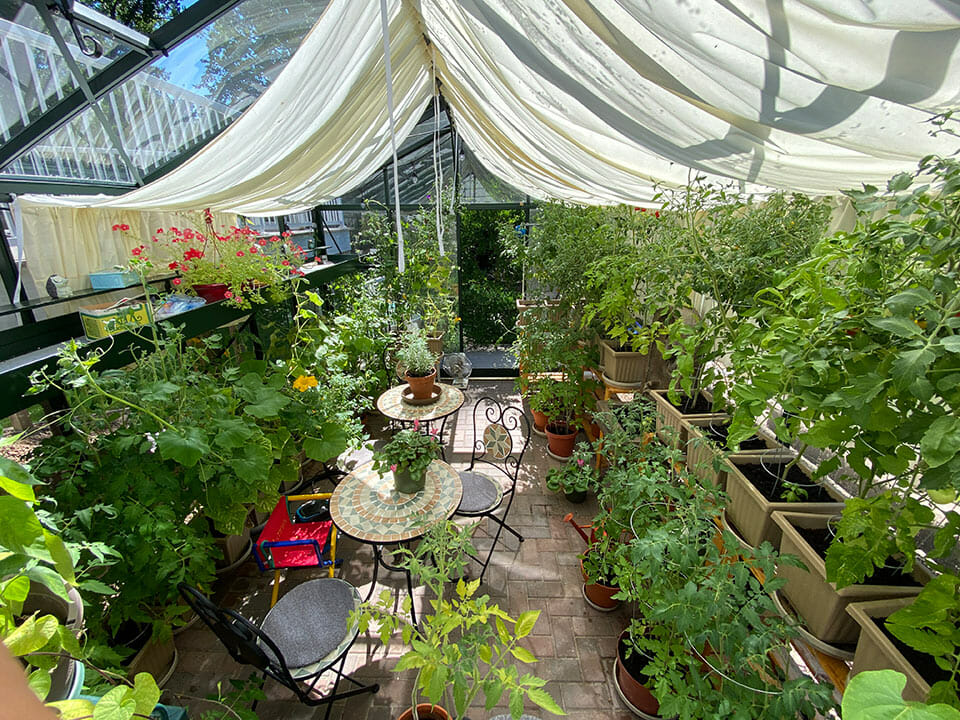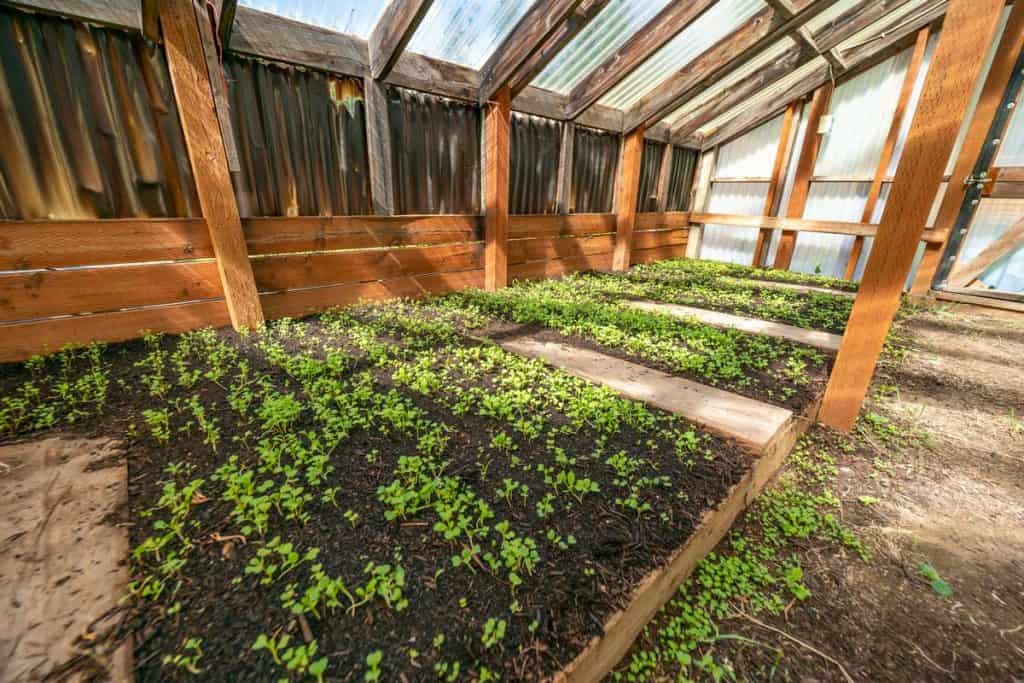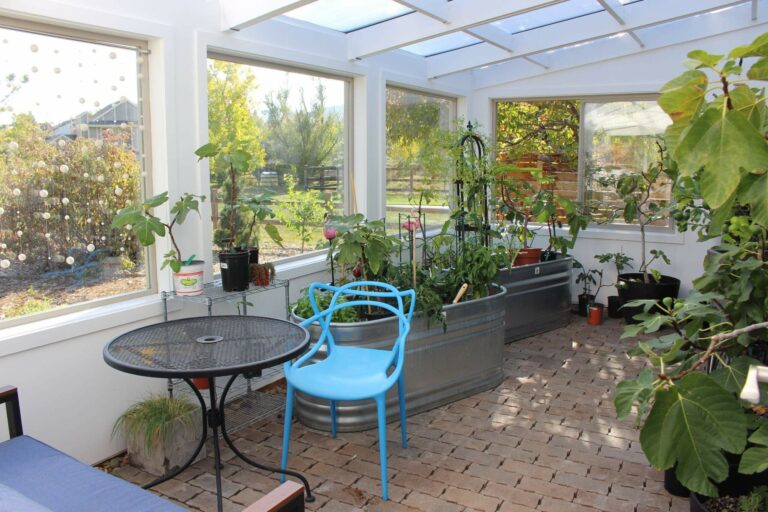As I step into my lush garden haven, the warm embrace of summer envelops me. The sun’s golden rays dance through the leaves, casting intricate patterns on the rich, green foliage. It’s a scene of serenity and growth, made possible by the one structure that has become my gardening ally throughout the seasons: my beloved greenhouse.
The concept of using a greenhouse during the summer might seem counterintuitive at first. After all, summer brings long, sun-drenched days and balmy evenings that seem tailor-made for outdoor gardening.
But here’s the secret – Yes, you can utilize a greenhouse during the summer, but it’s essential to manage the temperature and humidity inside to ensure optimal conditions for plant growth.
In this journey of discovery, you’ll delve into the question, “Can you use a greenhouse in the summer?” I’ll share with you the secrets of how to do it successfully.
Unlocking Summer’s Secrets: Harnessing the Power of Your Greenhouse

Ventilation: Proper airflow is crucial in the summer to prevent overheating. You can use roof vents, side vents, or exhaust fans to allow hot air to escape and create airflow.
Shade: Provide shade to reduce the intensity of sunlight and prevent plants from getting scorched. Shade cloth or shade paint applied to the glazing can help regulate the amount of light and heat entering the structure.
Watering: Plants in a greenhouse can dry out quickly in the summer, so it’s essential to maintain adequate moisture levels. Install a watering system with timers or hand-water your plants as needed.
Cooling systems: In addition to ventilation, you can use cooling systems such as misting systems or evaporative coolers to lower the temperature inside.
Heat-tolerant plants: Select plant varieties that can thrive in higher temperatures. Some plants, like tomatoes and peppers, thrive in the warmth of a summer growing environment.
Extend Your Growing Season: To enable gardening throughout the year, it’s essential to manage temperature extremes. These tactics will allow you to continue your gardening activities without disruption.
Prepare for the Next Growing Season: Ensure a seamless transition from one season to the next by planning ahead. Begin seeding plants for the upcoming colder months in late summer or early fall. This timing ensures there is still sufficient daylight for healthy plant growth, facilitating a year-round harvest.
Transition Crops for Storage: Your greenhouse can serve as an ideal space for certain crops like garlic and dry beans that require a well-ventilated and dry environment for drying before storage or use.
Additionally, you can utilize your greenhouse to dry tomatoes and facilitate the curing process for winter squash and gourds, effectively extending the lifespan and usability of these crops.
Create a Green Oasis: Transform your greenhouse into a serene sitting area to enjoy moments of tranquility and reflection, providing a soothing retreat amidst your garden endeavors.
Pruning and Thinning: Trim and thin your plants to improve air circulation. This can help prevent the buildup of heat and humidity, which can lead to mold and mildew.
Proper Shelving and Storage: Store tools, supplies, and materials in an organized manner to maximize space and airflow within the greenhouse.
Pest and Disease Control: Monitor your plants regularly for signs of pests and diseases. Increased heat and humidity can make plants more susceptible to these issues, so early detection and treatment are essential.
Timing: Manage the timing of your activities inside the greenhouse. It’s often best to work in the greenhouse during the cooler morning or late afternoon hours to avoid extreme heat.
How Do High Temperatures Affect Plants?
Heat Stress: Prolonged exposure to elevated temperatures can cause plants to experience heat stress. Symptoms of heat stress include wilting, drooping leaves, and a general appearance of distress. This occurs because increased temperatures lead to excessive water loss from the plant through transpiration.
Altered Photosynthesis: Extreme heat can disrupt the essential process of photosynthesis, which is critical for plant growth and development. Rising temperatures can cause plants to close their stomata (small openings on leaves) in an effort to conserve water. However, this also limits the intake of carbon dioxide necessary for photosynthesis, reducing the plant’s ability to produce energy and food.
Damage to Flowers and Fruits: High temperatures can interfere with the pollination process, resulting in poor fruit sets and deformed or sunburned fruits. Additionally, excessive heat can lead to the premature dropping of flowers and fruits.
Impact on Roots: Soil temperatures can significantly increase during a heatwave, potentially damaging plant roots. This can diminish their capacity to absorb water and nutrients from the soil, weakening the entire plant.
Impaired Nutrient Uptake: Elevated temperatures can impair the plant’s ability to absorb essential nutrients from the soil, potentially causing nutrient deficiencies and stunting growth.
Greater Vulnerability to Pests and Diseases: Stressed plants become more susceptible to insect infestations and diseases. Elevated temperatures can weaken a plant’s natural defenses, making it an easier target for pests and pathogens.
Accelerated Senescence: Extreme heat can accelerate the aging process in plants, resulting in yellowing leaves, withering, and premature leaf drop. This can reduce the overall health and vitality of the plant.
Reduced Growth: Prolonged exposure to high temperatures can slow down or even halt plant growth, which can be particularly detrimental for annual crops, affecting their ability to reach maturity and produce a harvest.
Tissue Damage: In severe cases, elevated temperatures can cause tissue damage, leading to brown or scorched leaves, stems, or flowers. This is often a sign of severe stress and can be irreversible.
Why is it Beneficial to Use a Greenhouse in the Summer?
During the summer months, depending on your geographical location, you typically experience hot weather. However, occasionally, unexpected weather phenomena like storms, sudden temperature drops, droughts, or prolonged rains can pose a threat to your crops.
Further, These abrupt changes in weather conditions can cause significant stress to plants grown outdoors, resulting in issues such as wilting cucumbers, sunburned tomatoes, dried-up herbs like dill and salad, and underdeveloped, watery berries.
In contrast, utilizing a greenhouse offers the advantage of climate control. You can adjust conditions as needed, employing shade cloth to reduce light exposure, ensuring continuous ventilation on scorching summer days, and protecting your plants from strong winds and rain, all while maintaining the required humidity levels. Furthermore, greenhouse gardening tends to have fewer weed problems, and pest infestations are typically less severe.
These artificially regulated conditions create an ideal environment for gardening activities. Even if you have limited growing space, you can achieve crop yields that are equivalent to or even surpass those obtained in open-ground cultivation.
Additionally, the controlled environment allows for multiple harvests throughout the summer.
Top ways to keep the greenhouse cool in summer
Install a Thermometer: To begin, it’s essential to monitor the temperature inside your greenhouse. Installing a thermometer allows you to track temperature fluctuations and ensure that conditions remain optimal for plant growth.
Implement Ventilation: Adequate airflow is a fundamental aspect of greenhouse cooling. Natural ventilation can be achieved through strategically placed air vents, including roof windows and louver vents.
Also, these vents allow hot air to escape and cooler air to circulate. Additionally, leaving greenhouse doors open can enhance airflow. Consider installing automatic vent openers that respond to temperature changes, ensuring continuous ventilation even when you’re not present.
Utilize Greenhouse Fans: Circulating air within the greenhouse can help reduce the overall temperature. Fans are an effective option for achieving this. Proper fan sizing, placement, and maintenance are essential factors to consider.
Typically, fans should provide one air exchange per minute for every 8 feet of greenhouse height. Combining fans with louvered vents can further enhance airflow.
Explore Evaporative Cooling: Evaporative cooling systems are an efficient and cost-effective means of reducing greenhouse temperatures. These systems operate by evaporating water, which cools the air. Fan-and-pad cooling systems are common examples.
Also, they work by drawing warm air through wet pads, cooling the greenhouse environment. Ensure you select the right-sized system based on your greenhouse’s floor area and regularly maintain it for optimal performance.
Consider Misting or Fogging Systems: Misting and fogging systems provide rapid and effective cooling. These systems release fine water droplets into the greenhouse, which evaporate, lowering the temperature. Foggers produce even smaller droplets for enhanced cooling. However, they are most effective in regions with low humidity as they add moisture to the air.
Practice Damping Down: Damping down involves wetting hard surfaces like paths and staging within the greenhouse. As the water evaporates, it increases humidity levels and aids in keeping the plants cool. This method is especially useful during extreme heat but should be used judiciously to prevent over-humidifying the environment.
Maintain Adequate Plant Watering: Properly watering your plants is essential to keep them cool and healthy. Through a process called transpiration, plants release moisture through their leaves, helping to cool them down. Ensure your plants receive the right amount of water to prevent stress and overheating.
Portable Air Conditioning: For larger greenhouses, portable air conditioning units can be effective in maintaining a cool environment. These units are energy-efficient and often include dehumidifiers, which help control humidity levels while cooling.
Strategic Planting: Planting large-leaved plants within the greenhouse, such as grapevines and fig trees, can provide shade for both the soil and the plants, reducing overall temperatures.
Additionally, positioning the greenhouse near deciduous trees can offer natural shade during the summer months while allowing sunlight in during colder seasons.
Shade Cloths and Curtains: Installing shade cloths or curtain systems is a cost-effective way to provide temporary shade within the greenhouse. These materials are available in various densities, allowing you to control the amount of light and heat entering the greenhouse. Choose a density that suits your local climate, greenhouse design, and plant requirements.
What Can You Grow in a Greenhouse in the Summer?

Tomatoes: Tomatoes thrive in warm and stable settings, often yielding larger and more flavorful fruits.
Cucumbers: These vegetables benefit from the warmth and protection from pests, and they can be trained to grow vertically, saving space.
Peppers: Both sweet and hot peppers do well in controlled settings due to the consistent temperatures and protection from the elements.
Eggplant: Eggplants enjoy the heat and can produce abundant harvests in a carefully controlled setting.
Herbs: Herbs like basil, cilantro, and mint thrive in controlled conditions, ensuring a steady supply throughout the summer.
Melons: Certain melon varieties, such as cantaloupes and honeydews, can be successfully grown under controlled conditions, resulting in sweet and flavorful fruits.
Crops with Long Growing Seasons: Controlled conditions allow for early planting of crops with long growing seasons, such as specific varieties of corn, pumpkins, and winter squash.
Lettuce and Greens: Leafy greens like lettuce, spinach, and kale can be cultivated throughout the summer without concern for premature bolting due to high temperatures.
Cabbage Family: Plants like cabbage, broccoli, and cauliflower can be grown in a controlled setting during the summer to avoid heat-related stress and ensure better head development.
Berries: Some berry varieties, including strawberries and raspberries, can be grown in containers or raised beds within a controlled setting to protect them from birds and adverse weather conditions.
Flowers: Controlled settings are excellent for cultivating various flowers, both for ornamental purposes and for use in floral arrangements.
Exotic or Tropical Plants: Controlled settings can simulate microclimates suitable for exotic or tropical plants that would not typically thrive outdoors in your region.
FAQs
What temperature is too hot for a greenhouse?
Generally, temperatures above 90°F (32°C) can be too hot for a greenhouse, potentially stressing plants and causing heat-related damage.
Are greenhouses good for summertime?
Yes, greenhouses are beneficial in the summertime for providing controlled conditions, protecting plants from extreme heat and pests, and extending the growing season.
Do greenhouses allow sunlight?
Yes, greenhouses are designed to allow sunlight in while providing shelter from harsh weather conditions. They optimize light for plant growth.
Do greenhouses protect from extreme heat?
Yes, Greenhouses can protect plants from extreme heat by providing shade, ventilation, and temperature control to create a favorable environment.
Do greenhouses need UV?
Yes, greenhouses allow essential UV (Ultraviolet) rays to pass through their coverings, which is important for photosynthesis and plant development.
Is a greenhouse better than outdoor one?
Greenhouses offer advantages like climate control, pest protection, and extended growing seasons, making them a valuable addition for many types of gardening. However, the choice between a greenhouse and outdoor gardening depends on specific needs and preferences.
Conclusion
To wrap up, Through the lens of my own gardening experiences, I’ve come to appreciate the myriad ways a greenhouse can transform your summer garden. It’s a space where you can nurture heat-loving tomatoes, peppers, and cucumbers, watching them thrive in a controlled environment.
But it’s not just about the plants. It’s about the peace of mind knowing that unexpected weather twists won’t disrupt your gardening aspirations. It’s about the joy of experimenting with exotic plants, enjoying the fruits of your labor, and creating a haven of greenery amidst the summer heat.
As I stand in my thriving summer greenhouse, surrounded by flourishing life, I can confidently say that yes, you can use a greenhouse in the summer. So, embrace the possibilities, tend to your plants with care, and let your greenhouse be the bridge between you and the summer garden of your dreams. The rewards are nothing short of extraordinary.

